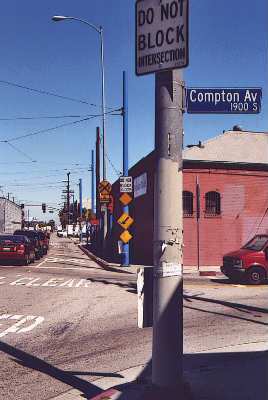Straight Outta Imagination
I went to Compton this past week after a long time away. I drive through it and around it on a regular basis, but I hadn't actually parked and walked in the city since I was called to jury duty at its courthouse a couple of years ago (the trial ended before it started when, after opening statements, the prosecution's only witness failed to show. This being the first time I'd ever been seated on a jury, I was disappointed. I wanted to see how justice worked, or didn't.)

Before that, I spent a lot of time in Compton ten years ago when I was writing a story for the L.A. Weekly about its flamboyant and controversial then-mayor, Omar Bradley. The first thing Bradley did, over my objections--he did most things over people's objections--was take me on a tour of Compton in his own car, with his beefy security guard riding in the back seat. It was a surreal experience in which Bradley alternately pointed out all the good he'd wrought in town and railed against the evil white media (of which I was a part, in his mind) that refused to see Compton as anything but a gang-infested ghetto. I had my issues with the mayor, but I sympathized with his view about the media. Compton was only the most egregious example of how papers routinely portrayed any black neighborhood in L.A. as a ghetto first, anything else second. That this was more or less the birthplace of gangsta rap, that musical genre that both repulses and enthralls white America, didn't help matters.
How fitting, then, that I went to City Hall this past week to support the city's efforts to respond to a recent, ugly attempt at character assassination that's still unfolding. Last month at UC San Diego, in 'honor' of Black History Month, members of a Greek fraternity sent out Facebook invites to a ghetto-themed party that it dubbed a "Compton Cookout." Partygoers were encouraged to show up with gold teeth, cheap hair weaves, bad English, that sort of thing. The invites sparked outrage amongst black students, who make up only 2% of the population there. Racial tensions mounted and more campus incidents followed: a noose was found, and a Klan hood fashioned out of a pillow case. Compton itself kept quiet initially, but then decided to publicly address the matter at its council meeting. I went to hear that and to hear the remarks of Daniel Widener, a history professor and head of the Black Studies Department at UCSD (full disclosure: he's also my cousin).
On the way to City Hall I had to admit that Compton felt different than it felt a decade ago. Much has been written about the turnaround that's happened here in the last several years, pieces I dismissed as patronizing in a white middle-class kind of way--the city gets a few more cops and a Starbucks, and suddenly everything is looking up? Please. But things had changed, and not just because of Starbucks (and Target, and a host of other retail outlets). Compton felt more alive, less isolated and to itself. The atmosphere was less tense and more relaxed. City Hall had a facelift that included a giant mural of Barack Obama, that new touchstone of black uplift. The discourse in council chambers was civil, almost dull, where it once was routinely combative when Omar Bradley was in charge.
And what became of Omar? (Around town he's always been known by his first name, like Prince or Madonna.) For all his indignation about the negative public perception of Compton, the fact is that Omar's antics only added to that perception. After being voted out of office in 2001, he was convicted of misappropriating public money in 2004 and served some prison time. He's been out of prison a good while, but can no longer hold elected office. After the council meeting, I asked one longtime local activist about him. She shook her head. "It's sad," she said. "He's got nothing to do. He sits all day in Starbucks talking to himself and telling anybody who'll listen that he got a bad deal. Imagine that."
This image was taken by flickr user Fire Monkey Fish. It was used under the Creative Commons License.


